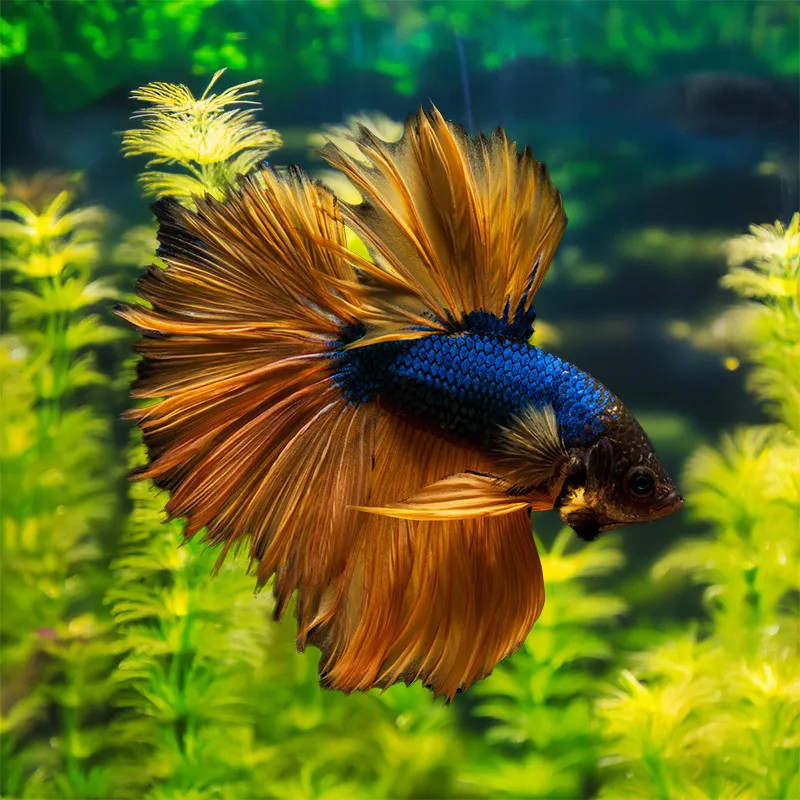Stocks Available
Crown Tail Betta - Female
SKU:100036
BETTA SPLENDENS
Natural

Stock Available
Introduction Species: Betta splendens Common Names: Royal Blue Mustard Betta, Mustard Gas Betta Natural Habitat The Royal Blue Mustard Betta originates from the shallow waters of Southeast Asia, including rice paddies, ponds, and slow-moving streams. These environments are characterized by warm, low-oxygen water, which the Betta adapts to with its labyrinth organ, allowing it to breathe atmospheric air. Physical Characteristics Appearance: The Royal Blue Mustard Betta is renowned for its striking contrast of colors. Its vibrant royal blue body transitions into mustard-yellow fins edged with dark borders, creating a dramatic, fiery appearance. The iridescent scales add a shimmering effect, enhancing its visual appeal. Size: Typically grows up to 2.5-3 inches (6-7.5 cm) in length. Lifespan: Lives 2-3 years with proper care. Habitat Requirements Tank Size: A minimum of 5 gallons is recommended for a single male Betta. Larger tanks are preferable for better water stability. Water Conditions: Temperature: 76-82°F (24-28°C) pH: 6.5-7.5 (neutral to slightly acidic) Hardness: Soft to moderately hard water (3-8 dGH). Aquascaping: Provide a well-planted tank with floating plants, driftwood, and caves for hiding. Betta fish appreciate low-flow water and subdued lighting to mimic their natural habitat. Diet Primary Diet: Carnivorous; in the wild, they feed on insects, larvae, and small invertebrates. Supplemental Feeding: In captivity, provide a diet of high-quality Betta pellets, freeze-dried or frozen bloodworms, brine shrimp, and daphnia. Occasional live foods can enhance their health and coloration. Feeding Frequency: Feed 2-3 small meals daily, avoiding overfeeding to maintain water quality. Compatibility Temperament: Male Bettas are territorial and aggressive toward other males and similar-looking fish. They do best as solitary fish or with carefully selected tank mates. Suitable Tank Mates: Peaceful, non-aggressive species like Corydoras, Kuhli Loaches, and small schooling fish (e.g., Neon Tetras) that do not have long, flowing fins. Incompatibilities: Avoid housing with other male Bettas, fin-nipping species, or fish with elaborate fins that might trigger aggression. Care Level Difficulty: Easy to Moderate; Bettas are hardy fish but require stable water conditions and proper tank setup to thrive. Health Monitoring: Watch for signs of fin rot, ich, or swim bladder issues. Regular water changes and maintaining good water quality are essential for their health. Breeding Breeding in Captivity: Breeding Bettas requires a separate tank and careful planning. Spawning Behavior: Males build bubble nests at the water’s surface to protect the eggs. After spawning, the male tends to the nest and the fry until they are free-swimming. Females should be removed post-spawning to prevent aggression. Economic Considerations Market Demand: Highly sought after by Betta enthusiasts for their unique coloration and vibrant patterns. Pricing: Prices vary based on the intensity of coloration, fin quality, and overall health. High-grade specimens command higher prices. Sustainability and Conservation Wild Population: Not endangered but habitat loss and pollution can threaten natural populations. Aquaculture Efforts: Widely bred in captivity to meet the growing demand while reducing pressure on wild populations. Conclusion The Royal Blue Mustard Betta is a stunning and charismatic fish that can be the centerpiece of any aquarium. With its vivid colors, graceful movements, and manageable care requirements, it is a favorite among aquarists of all experience levels. Providing a suitable environment and balanced diet will ensure this Betta thrives and displays its full splendor.
Data sheet
16 other products in the same category:
Customers who bought this product also bought: